The White-Headed Munia, also known as the Java Sparrow or Padda oryzivora, stands as a symbol of avian elegance and resilience in the diverse landscapes of Asia.
Its petite frame, adorned with a pristine white head juxtaposed against a sleek black tail, captures the imagination of bird enthusiasts worldwide.
Originally hailing from Indonesia, this species has ventured beyond its native shores, establishing populations across Southeast Asia and beyond, courtesy of human introductions.
Yet, it’s not just the bird’s physical allure that captivates; the intricate social behaviors and mating rituals truly set the White-Headed Munia apart.
Join me in unraveling the mysteries of this enchanting avian species as we delve into its habitat, behavior, and evolutionary adaptations.

Physical Characteristics of White-Headed Munia
The White-Headed Munia (Lonchura maja) possesses a set of physical characteristics that contribute to its unique appearance and distinguish it from other avian species:
Plumage
One of the most striking features of the White-Headed Munia is its plumage. As the name suggests, it has a white head and throat, contrasting sharply with the rest of its body.
The upper parts of the body are typically dark brown or black, while the underparts are lighter in the shade, often grayish-brown. During the breeding season, male White-Headed Munias may exhibit more vibrant colors to attract mates.
Young birds start with a dull brown plumage and gradually develop the characteristic white head after molting.
Size
Despite its small size, the White-Headed Munia is a notable bird. It measures around 11 to 12 centimeters (approximately 4.3 to 4.7 inches) from beak to tail tip.
It weighs between 10 and 15 grams (about 0.35 to 0.53 ounces), making it lightweight compared to many other bird species.
Facial Features
In addition to its distinctive plumage, the White-Headed Munia has notable facial features. It has a small, conical bill that is well-suited for feeding on seeds.
The eyes are typically dark brown, adding depth to its appearance. Its feet are adapted for perching, with tiny claws that aid in gripping branches and reeds.
Voice
The White-Headed Munia is known for its high-pitched vocalizations, often described as a “pee-pee” sound. These vocalizations serve various purposes, including communication within flocks, signaling danger, or attracting mates during breeding.
Habitat and Distribution of White-Headed Munia

The White-Headed Munia (Lonchura maja) is renowned for its expansive distribution across diverse Southeast Asian habitats.
Let’s delve into its habitat preferences and range:
Distribution
The White-Headed Munia inhabits several Southeast Asian countries, showcasing its adaptability to various environments. Its range includes:
- Indonesia: Found across multiple islands, including Sumatra, Java, and Bali.
- Malaysia: Widely distributed throughout the country.
- Brunei: Present, although less common compared to other regions.
- Thailand: Occurs in moderate numbers across different parts of the country.
- Vietnam: Found in certain areas, although its presence is relatively low compared to other countries in its range.
Habitat
The White-Headed Munia exhibits a remarkable ability to thrive in diverse habitats, including:
- Lowland Forests: These birds are often associated with lush lowland forests, where they find abundant food resources and suitable nesting sites. The dense foliage and diverse plant life provide ideal conditions for their survival.
- Human-Altered Landscapes: White-Headed Munias have adapted to human activities, inhabiting agricultural lands, plantations, and areas undergoing urbanization or land development. They can exploit resources in these environments, including cultivated crops and disturbed habitats.
- Grasslands and Open Areas: They are also found in grasslands, savannas, and open habitats with scattered vegetation. These areas offer access to seeds, which form a significant part of their diet. They may utilize tall grasses or shrubs for cover and nesting.
Diet and Breeding Habits of White-Headed Munia

The White-Headed Munia (Lonchura maja) exhibits distinct dietary preferences and breeding habits, which are essential for its survival and reproductive success:
Diet
- Seed-Eating Specialists: White-Headed Munias are primarily seed-eaters who are fond of grass seeds and grains. They are often found foraging in grassy areas, agricultural fields, and rice paddies, gleaning seeds from various plant species.
- Supplementary Insectivory: While seeds form the bulk of their diet, especially outside the breeding season, White-Headed Munias also supplement their nutrition with insects, particularly during the breeding season. This extra protein intake is crucial for supporting egg production in females and promoting the healthy growth of chicks.
- Flocking Behavior: These birds often exhibit gregarious feeding behavior, forming large flocks during foraging. Flocking provides them with safety in numbers and increases their efficiency in locating and exploiting food resources.
Breeding Habits
- Monogamous Breeding: During the breeding season, which typically occurs from April to October, White-Headed Munias engage in monogamous pair bonding. Males and females form exclusive breeding pairs and cooperate in various aspects of reproduction.
- Nest Construction: White-Headed Munias are adept nest builders, creating intricately woven spherical nests from grass and other plant materials. These nests are often placed in dense vegetation or shrubs to protect them from predators and the elements.
- Clutch Size and Incubation: The typical clutch size of White-Headed Munias ranges from four to six eggs. Incubation, primarily carried out by both parents, lasts approximately two weeks. The parents ensure the eggs are kept warm and safe during this period.
- Parental Care: After hatching, both parents feed and care for the chicks. They diligently provision the nestlings with a combination of seeds and insects to meet their nutritional needs. Even after fledging, the juveniles may remain with their parents for some time, learning essential survival skills before becoming independent.
Conservation Status of White-Headed Munia

The White-Headed Munia, currently classified as “Least Concern” on the IUCN Red List, is a bird species native to certain parts of Southeast Asia.
While this classification indicates that the species is not facing immediate threats of extinction, ongoing conservation efforts are still crucial to ensure their long-term survival.
Threats and Concerns
Despite its current status, the White-Headed Munia is not immune to potential threats, with habitat loss being a significant concern.
Deforestation, driven by urbanization and agricultural expansion, poses a risk to their natural habitats, potentially leading to population declines in the future.
Ecological Importance
It’s essential to recognize the White-Headed Munia’s environmental role within its ecosystem. By controlling insect populations through predation and contributing to seed dispersal through their diet choices, these birds help maintain the balance of their habitats.
Conservation Efforts
Several countries where the White-Headed Munia is found have implemented laws and regulations to protect them from poaching and illegal pet trade. These are significant threats faced by bird species globally.
These conservation measures are essential for safeguarding the species and ensuring their populations remain stable.
Monitoring and Vigilance
While the conservation status of the White-Headed Munia has remained stable over the past decade, ongoing monitoring and vigilance are crucial.
Continued efforts to assess population trends, address emerging threats, and protect critical habitats are necessary to prevent future declines in their numbers.
FAQs
What is the lifespan of a White-Headed Munia in the wild?
White-Headed Munias typically have a lifespan of about 3 to 5 years in the wild. However, factors such as predation, habitat quality, and availability of resources can influence individual longevity.
How do White-Headed Munias communicate with each other?
White-Headed Munias communicate through various vocalizations, including chirps, calls, and songs. These vocalizations are used for mate attraction, territorial defense, and cohesion within flocks.
Do White-Headed Munias migrate?
White-Headed Munias are generally non-migratory birds, although some populations may exhibit seasonal movements in response to changing environmental conditions or food availability.
Are White-Headed Munias aggressive towards other bird species?
White-Headed Munias are generally not aggressive towards other bird species. However, they may compete with other birds for food and nesting sites, particularly in areas with limited resources.
How do White-Headed Munias defend their nests from predators?
White-Headed Munias employ various strategies to defend their nests from predators, including mobbing behavior, where they collectively attack and harass potential threats such as snakes, birds of prey, and mammals.
Conclusion
The White-Headed Munia is a captivating emblem of nature’s beauty and resilience. With its distinctive white-capped appearance and social behaviors, this species offers a window into the intricate world of avian life.
From its specialized diet of grass seeds to its adept nest-building skills, each aspect of the White-Headed Munia’s existence reflects its adaptation to its habitat.
Understanding and conserving species like the White-Headed Munia becomes paramount as we navigate an era of environmental change.
Through continued research, conservation efforts, and appreciation of their presence, we can ensure these charming birds continue to grace our landscapes, reminding us of the profound interconnectedness of all life on Earth.